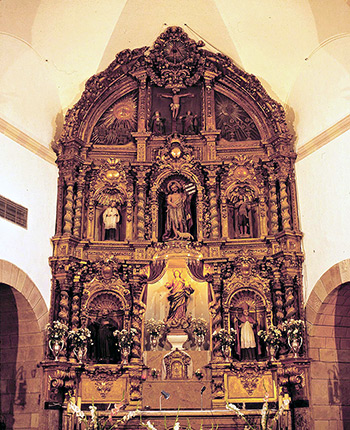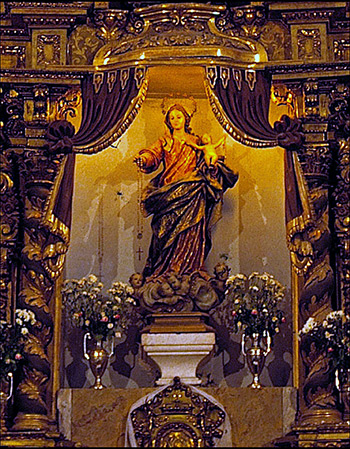Route through the 18th century altarpieces of Baztania
Main altarpiece of Arizkun
It was contracted in 1693 by Juan de Oyerena, a master sculptor and architect residing in Elizondo, and valued in 1699 by Martín de Legarra from Pamplona. The executor was only a local master, eventually a good carpenter, while the latter had more regional projection. Among his activity we should highlight the disappeared altarpiece of the Discalced Carmelites of Pamplona, contracted by Miguel Martínez de Heredia, secretary of the Holy Crusade, under the supervision of the discalced Carmelite friar Martín de San José in 1682, as well as the bidding for the Larraga altarpiece in 1696 and the execution with Pedro de Leceta of the main altarpiece of the parish of San Román de Cirauqui, in addition to various appraisals.
The structure of the main altarpiece of the parish of Arizkun is made up of two bodies with several niches and a semicircular attic articulated by salomónicas and with abundant decoration, not by a great carver but by a specialized carpenter. Shortly after, before 1703, the piece was completed with six sculptures of Saint Fermin, Saint Francis Xavier, Saint Stephen, Saint Lawrence, Saint John and Mary, discreet works by the Villava sculptor Miguel Sagüés, only partially preserved. This sculptor contributed his works to different master altarpieces of Pamplona at the end of the XVII century and the first decades of the XVIII century.
The history of the altarpiece continued with important decorative additions, gilding and sculpture. Between 1735 and 1741 ornamental motifs were introduced, a dynamic tabernacle with its canopy, works that were at position of José Pérez de Eulate (1741-1783), overseer of works of the diocese and author of numerous projects among which the execution of the main altarpiece of the Poor Clares of the same town (1736) or the traces of the altarpieces of the Benedictine nuns of Corella (1741) stand out. At the same time, two busts of the Dolorosa and Christ were placed in the parish sacristy. The parochial accounts of 1742 include the items corresponding to the payment of the gilding, which was done by the Madrid painter Pablo de Castro, who worked at that time in the convent of the Poor Clares of Arizkun. Finally, around 1756-1757 the A image of the Virgin of the Rosary arrived from Madrid, a gift from Don Francisco Miguel de Goyeneche y Balanza, Count of Saceda and steward of Isabel de Farnesio. The new niche for the sculpture was made by José Coral, from Pamplona.
CRUZ YABAR, M. T., "José de Hermosilla y el retablo de Irurita en Navarra", file Español de Arte, n.º 290 (2000), pp. 51-65.
FERNÁNDEZ GRACIA, R., El retablo barroco en Navarra, Pamplona, Government of Navarre, 2003.
FERNÁNDEZ GRACIA, R., "El triunfo del Academicismo en los retablos baztaneses y el project para el mayor de Villafranca (1783) en un dibujo de la Library Services Nacional", Studium, Magisterium et amicitia. Homage to professor Agustín González Enciso (ed. R. Torres Sánchez), Pamplona, Eunate, 2018, pp. 467-478.
FERNÁNDEZ GRACIA, R., "En torno a la registration de la Virgen del Rosario de Irurita, obra de Juan Domingo Olivieri, de 1749", Pieza del mes de marzo de 2023. Chair de Patrimonio y Arte Navarro.
GARCÍA GAINZA, M.ª C., "Virgen del Rosario, signed by Olivieri", file Español de Arte, n.º 235 (1986), pp. 324-329.
GARCÍA GAINZA, M.ª C., El escultor Luis Salvador Carmona, Pamplona, University of Navarra, 1990.
GARCÍA GAINZA, M.ª C., "Sobre las esculturas de Luis Salvador Carmona en Lekaroz", Cuadernos de la Chair de Patrimonio y Arte Navarro, n.º 2, Pamplona, 2008, pp. 243-255.
GARCÍA GAÍNZA, M.ª C., "Alonso Cano y José Ribera, fuentes inspiradoras en la obra de Luis Salvador Carmona: el martirio de san Bartolomé de Lekaroz", Pieza del mes de mayo de 2015. Chair de Patrimonio y arte navarro.
MARTÍN GONZÁLEZ, J. J., "Problemática del retablo bajo Carlos III", Fragmentos n.º 12-14 (1988), pp. 33-43.










